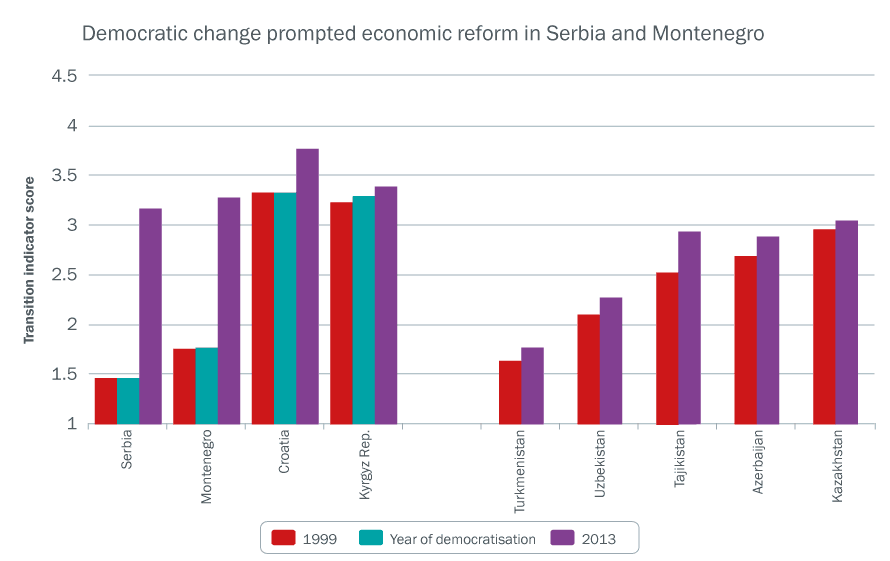Convergence at risk
Reform stagnation
- Details
- Convergence at risk
In the early 1990s countries in the transition region faced sizeable productivity gaps due to inherited capital and production structures, but also owing to inadequate and ineffective institutions supporting economic activity. Structural reforms, as measured by the average of the EBRD’s six country-level transition indicators (see the section of this Transition Report entitled “Progress in transition: structural reforms”), advanced rapidly until the end of the decade. Thereafter the reform process began to lose momentum, and by the mid-2000s it was stagnating in most EBRD countries of operations (see Chart 1.5a).
In part, the slowing of reforms simply reflected the fact that transition economies were catching up with advanced market economies. Price liberalisation, small-scale privatisation and the opening-up of trade and foreign exchange markets, which trigger large “upgrades” on the EBRD’s transition indicator scale, were mostly complete by the end of the 1990s. However, Chart 1.5b shows that reforms slowed even in areas such as governance, enterprise reform and competition policy, which remain substantially below the standard of advanced economies in virtually all countries in the transition region. Furthermore, reform stagnation set in, particularly in the EEC countries, Russia and Central Asia, where market structures and institutions lag far behind those in advanced economies. Most of the countries that have stalled at particular transition levels since the mid-2000s cannot remain there without compromising their long-term growth prospects.1What are the chances that they will recover their momentum? At this point it is useful to consider the striking correlation between the transition indicators and the quality of political institutions – specifically, the degree to which societies are democratically organised, as gauged by a widely used database, the Polity IV dataset (see Chart 1.6). Without exception, those countries which score highly on an index of democratisation have achieved at least reasonable progress towards market-oriented economic institutions.
The correlation shown in the chart may not necessarily reflect a causal relationship between political institutions and economic reform. However, a body of influential literature in the fields of economics and political science (which is discussed in more detail in Chapters 2 and 3 of this Transition Report) asserts that there may be such a relationship, and that it may work in both directions. In particular, political regimes in the transition region can have an effect on the type and quality of economic institutions.
A simple way to see this is to examine the consequences of political regime change for economic reform. For the most part, the political systems in the countries featured in Chart 1.6 came about soon after the end of communism in the late 1980s and early 1990s, but there were some important exceptions. In the early 1990s Croatia, the Kyrgyz Republic, Montenegro and Serbia (the last two being part of the same country at the time) had negative values on the Polity scale (see Chart 1.7), but they eventually became democracies. Belarus, on the other hand, had a level of democracy that was broadly comparable to a number of CEB and SEE countries following its independence in 1992, but its political institutions took a sharp turn for the worse in the mid-1990s. These political transitions – which were driven largely by factors unrelated to contemporaneous economic developments, such as geography, internal struggles and external military intervention – seem to predict the subsequent level of success (or the lack of it) as regards economic reform.
Chart 1.8 compares economic reforms in Belarus with a comparator group of transition countries that had similar political ratings in 1993 (that is to say, countries with Polity scores of between 5 and 9). All the comparators except Armenia maintained or improved their democracy scores between 1993 and 2013. In contrast, Belarus’ score declined from 7 between 1991 and 1994 to 0 in 1995 and -7 in 1996, and has remained at that level ever since. The chart shows that by 2013 Belarus had achieved an economic transition score of just over 2 (on a scale ranging from 1 to 4+), while all comparator countries had exceeded 3 (see right-hand bars for each country in Chart 1.8). This does not only reflect a lack of reform following its democratic reversal, as Belarus was already lagging behind most comparator countries by that point. Nevertheless, most of the difference between the 2013 transition scores for Belarus and the other countries seems to be attributable to its political institutions, which have prevented economic reform from progressing.
Chart 1.9 shows the result of countries moving in the opposite direction. In 1993 Croatia, the Kyrgyz Republic, Montenegro and Serbia were all assigned negative values under the Polity index (with scores ranging from -7 in the federation comprising Serbia and Montenegro under Slobodan Milošević to -3 in the other two countries). They all subsequently became full multi-party democracies: Croatia, Montenegro and Serbia in 2000, and the Kyrgyz Republic in two steps, in 2005 and 2011. In the chart the reform trajectories of these four countries are compared with those of other countries in the transition region whose Polity scores have remained negative over the last 20 years – Turkmenistan and Uzbekistan (both assigned scores of -9 in 1993), as well as Tajikistan (-6), Azerbaijan (-3) and Kazakhstan (-3).
Chart 1.9 shows that the four countries which eventually became multi-party democracies have carried reform further than those that have made less political progress, eventually achieving transition scores in excess of 3. Reforms carried out in Serbia and Montenegro after the end of the Milošević era were particularly impressive. As in the case of Belarus, there is a sense that economic reforms in these countries were affected by political institutions.
But Chart 1.9 also suggests that political regimes are not the whole story when it comes to explaining differences in reform trajectories. Although Azerbaijan and Kazakhstan have never had an average transition score of more than 3, they have managed to implement significant reforms in spite of their Polity classifications. In the Kyrgyz Republic democracy does not seem to have helped to improve economic institutions, a puzzle to which we return in Chapter 3.
While democracy appears to be neither a necessary nor a sufficient condition for successful economic reform, more democratic systems of government have tended to take reforms further than other political systems in the transition region. With only two exceptions – Croatia and the Kyrgyz Republic in the 1990s, both of which had relatively pluralistic regimes, even though Polity did not consider them democracies at the time – no country with a negative Polity2 rating has been able to push reforms beyond a transition rating of 3 (on a scale ranging from 1 to 4+). The stagnation of reform in these countries could be taken to imply that the reform process has reached the limits of what is feasible within the constraints of prevailing political institutions.
- Several studies provide evidence for a link between reforms and long-term growth in transition economies. See Campos and Coricelli (2002) and Falcetti et al. (2006).[back]














